At This Old House, we’ve seen firsthand how even minor changes can breathe new life into a bathroom. From a newly tiled floor to a gleaming chrome faucet, these improvements can make a significant impact.
Whether you’re looking to update a small bathroom on a budget or completely revamp your space, we’ve compiled 13 weekend-worthy ideas that are sure to elevate your bathroom’s style and functionality.
1. Build a Vintage Dresser Bathroom Vanity
Incorporating vintage elements into your bathroom can add character and charm. A vintage dresser repurposed as a vanity is an excellent way to achieve this look while also providing ample storage space. This project combines the nostalgia of a wash basin with modern plumbing conveniences.
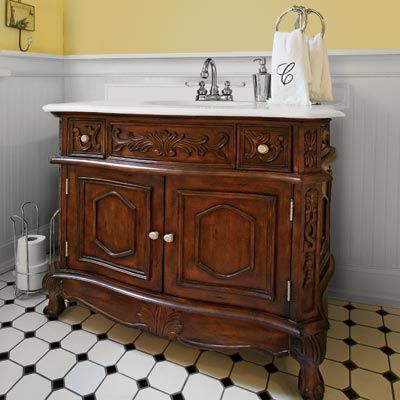
To create your own vintage-inspired bathroom vanity:
- Choose a sturdy dresser with good bones and the right dimensions for your space.
- Remove drawers and modify the interior to accommodate plumbing.
- Cut holes for the sink and faucet.
- Apply a water-resistant finish to protect the wood.
- Install the sink, faucet, and plumbing connections.
Repurposing an old furniture piece not only adds unique charm but also promotes sustainability. Additionally, it can offer a versatile surface for unusual sink shapes, giving your bathroom a custom look.
For a detailed guide on this transformation, check out our article on How to Turn a Dresser into a Bathroom Vanity.
2. Install a Pedestal Bathroom Sink
A porcelain pedestal sink is a timeless addition that can instantly elevate the elegance of your bathroom. Not only does it exude sophistication, but it’s also an excellent space-saving solution for smaller bathrooms. Installing a pedestal sink can be a manageable DIY project for those with some plumbing experience.
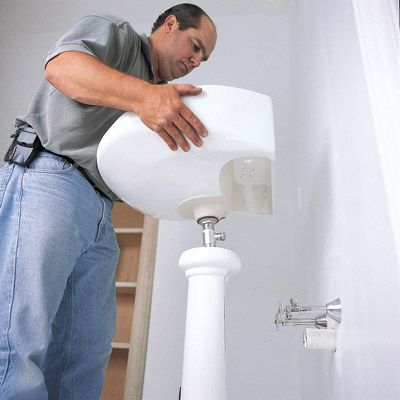
Key steps in installing a pedestal sink include:
- Removing the old sink and preparing the area
- Installing new water supply lines and drain pipe if necessary
- Mounting the sink basin to the wall
- Attaching the pedestal and making final connections
Furthermore, pedestal sinks offer an airy feel, making even small spaces appear larger. They are available in various styles, from classic to contemporary, fitting seamlessly into any bathroom décor.
For a comprehensive guide on tackling this project yourself, refer to our article on How to Install a Pedestal Sink.
3. Anchor a Towel Bar
While a dry towel may seem light, a wet towel can put significant strain on poorly installed hardware. Proper installation ensures your towel bar remains firmly in place, keeping your towels off the floor and your walls intact.
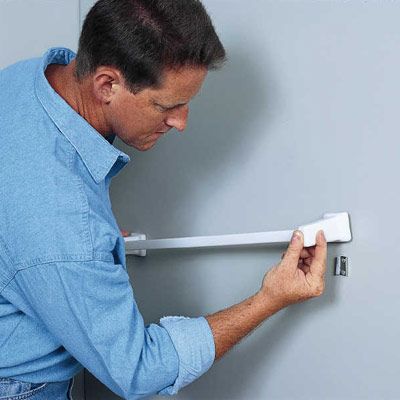
To properly anchor a towel bar:
- Locate wall studs using a stud finder
- Mark the desired location for the towel bar
- Use appropriate anchors for your wall type if studs are not available
- Pre-drill holes and install the mounting brackets
- Attach the towel bar to the brackets
A well-anchored towel bar also offers additional hanging space for bathrobes or extra towels. It may even serve aesthetic purposes, acting as a feature that complements your bathroom’s overall design.
For more detailed instructions, check out our guide on How to Anchor a Towel Bar.
4. Install a Shower Door
Upgrading from a shower curtain to a glass shower door can dramatically improve your bathroom’s appearance and functionality. A well-installed shower door not only looks sleek but also helps contain water more effectively, protecting your bathroom floor from water damage.
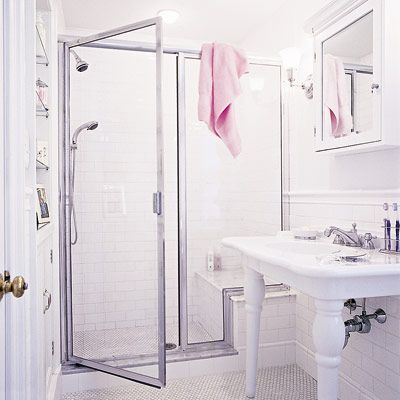
Shower doors are available in various finishes and styles, such as frameless options that offer a modern look. They provide a seamless transition between the shower and the rest of the bathroom, enhancing the overall visual appeal. For a step-by-step guide on this upgrade, refer to our article on How to Install a Shower Door.
5. Tile Around a Tub
Tiling around your tub is an excellent way to enhance both the aesthetics and functionality of your bathroom. This project can provide water resistance, stain protection, and a fresh pop of color. While it may seem daunting, tiling around a tub is an achievable DIY project with proper planning and execution.
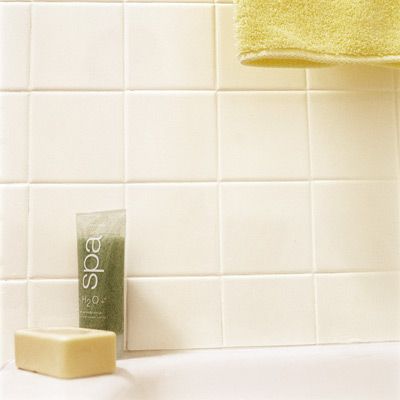
Key steps in tiling around a tub include:
- Preparing the surface by removing old tile or wallboard
- Installing a cement backer board
- Planning the tile layout
- Applying thinset mortar and setting the tiles
- Grouting and sealing the finished surface
Adding a decorative border or mosaic tile inset can further personalize your tub surround and serve as a striking focal point. Additionally, maintenance becomes easier with durable tile surfaces that are simple to clean and resistant to mold and mildew. For a comprehensive guide on this transformation, check out our article on How to Tile Around a Tub.
6. Install a Medicine Cabinet
A medicine cabinet is a practical addition that can significantly increase storage space in your bathroom. It provides a convenient place to store toiletries, medications, and other small items while keeping your countertops clutter-free. Installing a medicine cabinet can be a straightforward DIY project that makes a big impact on your bathroom’s organization and functionality.
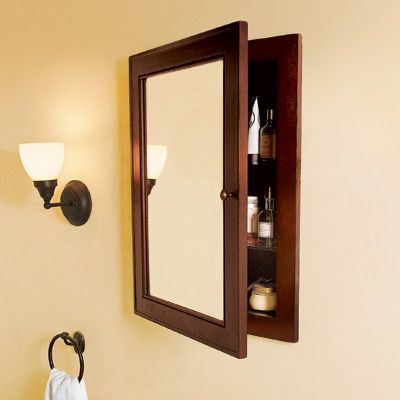
To install a medicine cabinet:
- Choose a cabinet that fits your space and style
- Locate wall studs for secure mounting
- Mark and cut the opening if installing a recessed cabinet
- Install blocking between studs if necessary
- Mount the cabinet and ensure it’s level
Selecting a mirrored medicine cabinet can double its utility, providing an extra mirror while enhancing light and space. These cabinets come in various designs and finishes, allowing you to find one that perfectly complements your bathroom’s decor. For more detailed instructions, refer to our guide on How to Install a Medicine Cabinet.
7. Make a Vintage Towel Rack
Adding a vintage-inspired towel rack can bring character and charm to your bathroom while providing functional storage. This unique project combines old-world aesthetics with modern practicality, creating a one-of-a-kind fixture for hanging and storing towels.
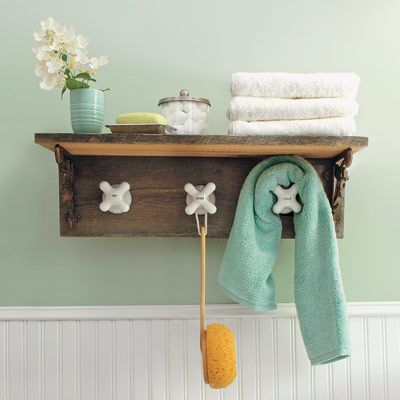
To create a vintage towel rack using old taps:
- Source vintage taps or faucet handles.
- Clean and restore the taps if necessary.
- Mount a sturdy board to serve as the base.
- Attach the taps to the board securely.
- Add hooks or bars for hanging towels.
This project allows for creativity with the finish and arrangement of the taps. You can enhance it further by painting or staining the baseboard to match your bathroom’s color scheme. For a step-by-step guide on creating this distinctive bathroom accessory, check out our article on How to Make a Towel Rack with Vintage Taps.
8. Install a Bathroom Vent Fan
A properly installed bathroom vent helps eliminate steam from showers, reduces odors, and prevents the growth of mold and mildew on walls and ceilings. Installing a vent fan can significantly improve your bathroom’s comfort and longevity.
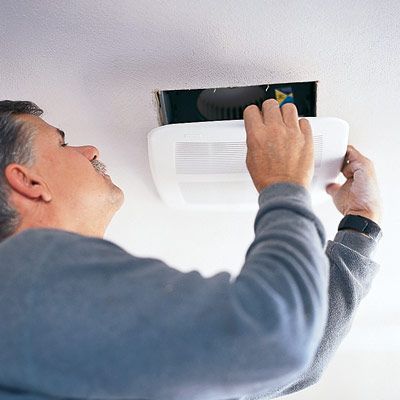
Key steps in installing a bathroom vent fan include:
- Choosing the right size and type of fan for your space
- Locating an appropriate spot for installation
- Cutting an opening in the ceiling
- Installing the fan housing and connecting the ductwork
- Wiring the fan and installing the grille
A vent fan equipped with additional features, such as a heater or light, can further enhance its functionality. Along with improving air circulation, these fans can help regulate temperature and lighting in your bathroom. For detailed instructions on this important upgrade, refer to our guide on How to Install a Bathroom Vent Fan.
9. Replace a Bathroom Faucet
A new faucet not only enhances the look of your sink area but can also provide better water flow and efficiency. This project is typically achievable in a couple of hours and can make a significant impact on your daily routine.
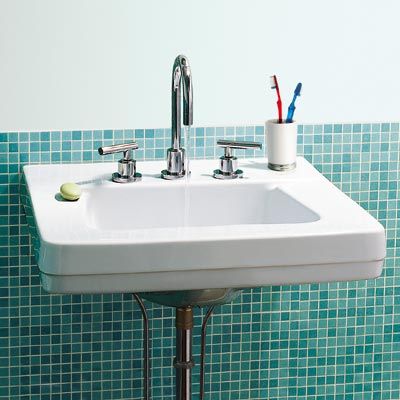
To replace a bathroom faucet:
- Turn off the water supply and remove the old faucet
- Clean the sink surface thoroughly
- Install the new faucet according to manufacturer’s instructions
- Connect water supply lines and check for leaks
- Caulk around the base of the new faucet for a finished look
New faucets are available in numerous styles and finishes, allowing you to coordinate with other bathroom fixtures for a cohesive look. Some models also offer water-saving features, making them an environmentally friendly choice. For a comprehensive guide on this upgrade, check out our article on How to Replace a Bathroom Faucet.
10. Install a Soap Dish
A well-placed soap dish can greatly enhance your shower experience by keeping your soap easily accessible and preventing it from becoming a soggy mess. Installing a soap dish is a simple project that can make a noticeable difference in your shower’s functionality and appearance.
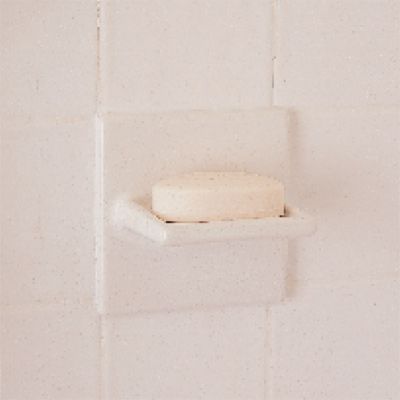
To install a soap dish:
- Choose a location that’s convenient but out of the direct water stream
- Mark the position and drill pilot holes if necessary
- Apply adhesive or use anchors depending on your shower’s surface
- Secure the soap dish in place
- Allow proper drying time before use
Choosing a soap dish that complements your shower’s aesthetic can add a stylish touch. From ceramic to stainless steel, there are options to suit any décor style. For more detailed instructions on this small but impactful upgrade, refer to our guide on How to Install a Soap Dish.
11. Caulk Around the Tub
Over time, old caulk can become discolored, cracked, or moldy, necessitating replacement. Re-caulking is a relatively simple DIY task that can significantly improve your bathroom’s look and functionality.
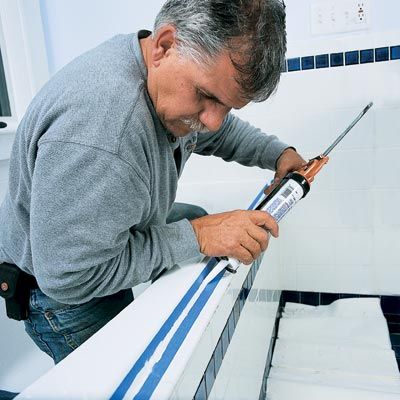
To caulk around a tub:
- Remove old caulk completely.
- Clean and dry the area thoroughly.
- Apply painter’s tape for clean lines.
- Cut the caulk tube nozzle at a 45-degree angle.
- Apply caulk smoothly and consistently.
- Remove the tape and allow the caulk to dry fully.
Using a quality, mold-resistant caulk can prolong the life of the seal and keep your bathroom looking pristine. It’s also a good idea to regularly inspect caulk lines and replace them as needed to avoid potential water damage. For a step-by-step guide on this important maintenance task, check out our article on How to Caulk Around a Tub.
12. Tile the Bathroom Floor
While it requires some skill and patience, tiling a floor is a project that many DIY enthusiasts can tackle successfully. A new tile floor can brighten your bathroom and create a fresh, clean look.
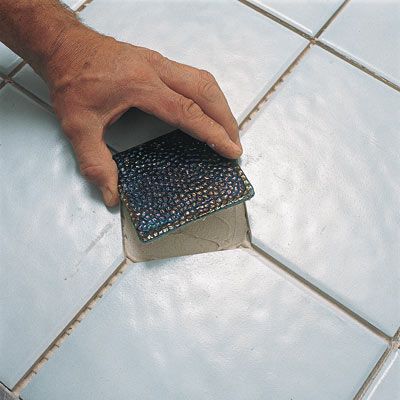
Key steps in tiling a bathroom floor include:
- Preparing the subfloor
- Planning the tile layout
- Applying thinset mortar
- Setting and spacing the tiles
- Cutting tiles as needed
- Grouting and sealing the finished floor
Opting for non-slip tiles can ensure safety, especially in a bathroom where floors can get wet. Additionally, heated tile floors can provide added comfort, making your bathroom warm during colder seasons. For a comprehensive guide on this transformative project, refer to our article on How to Tile a Floor.
13. Install a New Toilet
Modern toilets often feature water-saving designs and improved flushing mechanisms. While installing a toilet may seem daunting, it’s a project that many homeowners can tackle with the right guidance.
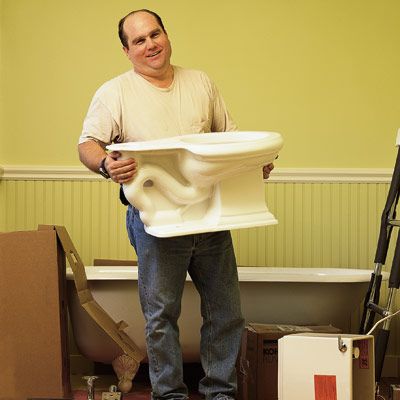
To install a new toilet:
- Remove the old toilet.
- Inspect and replace the flange if necessary.
- Install a new wax ring.
- Set the new toilet bowl in place.
- Attach the tank and connect the water supply.
- Test for leaks and proper function.
Moreover, dual-flush and low-flow toilets offer significant water savings and environmental benefits. With various designs available, you can choose a model that fits both your bathroom aesthetic and eco-friendly goals. For detailed instructions on this important bathroom upgrade, check out our guide on How to Install a Toilet.
Whether you’re looking to make small changes or tackle larger renovations, these ideas offer a range of options to suit various skill levels and budgets. Remember, even minor improvements can make a significant impact on your bathroom’s functionality and appearance. Enjoy the process of enhancing your bathroom and adding value to your home.
